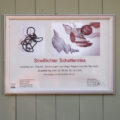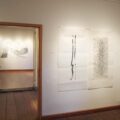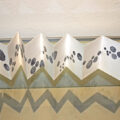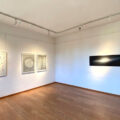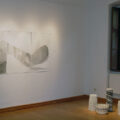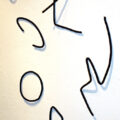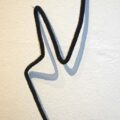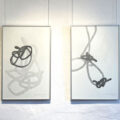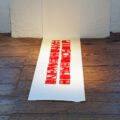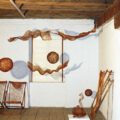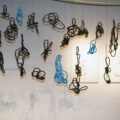Exhibitions
STREIFLICHTER – SCHATTENRISS
SIDELIGHTS – SHADOWS
2024
Galerie am Kietz, Schwedt
Ute Wennrich
Helga Wagner
The natural state of the cosmos is mostly darkness. It consists of dark energy and dark matter, a blackness from which stars and suns emerge as luminous spots as we perceive them. The earth is one of several planets in the solar system that orbit the sun.
We are very fortunate to be living on a planet that spins on an invisible line – its axis, allowing the change from light to dark, from day to night. Half of the Earth is always facing the sun and is lit up while the other half is in darkness until it turns around.
In the Book of Genesis the phenomenon of light, after there first had only been darkness, was already praised as the beginning of life as we know it. Among other factors, light has indeed played a major part in the development of life on Earth.
It is precisely the alternation of light and shadow that play a particularly important role for life. It lets movement, rhythm, as well as the factor of time gain great significance. Light itself is movement, namely waves in spectral colours. Light allows us to see things that need shadow in order to be perceived three-dimensionally.
Flashes of light illuminate a place or a scene for a moment, just a flicker, and then it’s over. What’s left is a visual memory or a brief impression.
Both artists displaying their works here dealt with these phenomena in various ways and have hereto designed this exhibition.
Helga Wagner’s installation 'Schatten fliegen voraus - zwischen den Welten' ('Shadows Are Flying Ahead – between Worlds') focuses on the aspect of movement and thus on a time-determined rhythm between the worlds as well as on the consistency of the material copper wire. In addition to the visual aspect of shadow formation this work reflects in a special way a section of time that the viewer perceives in his own context.
For Ute Wennrich, the rhythms of light and dark as well as movement play a central role, too. About the method of creating her drawings shown here, such as 'Quasi schwarze Löcher' ('Quasi Black Holes') or 'Heer – Scharen' ('Heavenly Swarms'), she says: “The pen hops, skips and dances over the paper, leaving a fine drop of ink on its trail with every dot. Just as in a dance, it moves in small bounces and big leaps, the countless dots cluster together forming a wide or dense surface.”
In the microcosm of the dot lies a whole world, and with its sequence and superimposition surfaces in different shades of grey are created that have a picturesque and at the same time a transparent appearance.
In addition to the works on paper, the exhibition features two essential materials. In Helga Wagner’s case, it is copper wire and in Ute Wennrich’s so-called rocailles, tiny glass beads. Both materials come from the earth and reflect the history of their origin. Light and shadow are indispensible components of the artists’ installations and objects, in which transparency becomes observable, both visually and metaphorically.
At the same time, in some works shown here, both artists deal with the immense and hardly conceivable dimensions of galaxies in which our solar system moves as a small unit. For example, in Ute Wennrich’s 'GalaXia 1', spots of light appear in the dark as if from distant suns, conveying a feeling of enormous vastness. While in Helga Wagner’s 'Galaxy', there is a sense of rapid motion, of celestial bodies racing through space.
Such celestial phenomena can only be seen from the Earth in darkness, which emphasises the importance of shadow. We now live in an age in which artificial light is very much a part of our daily lives. We often refer to it as light pollution. Already at the beginning of the last century Tanizaki Jun’ichiro lamented in his essay 'Praise of the Shadow' about how the use of a lot of artificial light had changed the effect and thus the perception of interiors in Japanese homes to the detriment. Perhaps it is time to become more aware of the relevance of shadow and darkness and the impact they have on our lives.
Dear guests, these thoughts only cast a few glimpses on what you can discover here and should only be regarded as mere suggestions. We are inviting you to an exciting, sensual tour of the exhibition and are looking forward to talking to you.
Ute Wennrich
translation Hanne Schestak



